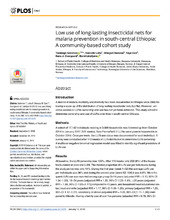| dc.contributor.author | Shanka, Tarekegn Solomon | en_US |
| dc.contributor.author | Loha, Eskindir | en_US |
| dc.contributor.author | Deressa, Wakgari | en_US |
| dc.contributor.author | Gari, Taye | en_US |
| dc.contributor.author | Overgaard, Hans Jørgen | en_US |
| dc.contributor.author | Lindtjorn, Bernt | en_US |
| dc.date.accessioned | 2020-05-11T08:53:51Z | |
| dc.date.available | 2020-05-11T08:53:51Z | |
| dc.date.issued | 2019-01-10 | |
| dc.Published | Shanka TS, Loha E, Deressa W, Gari T, Overgaard HJ, Lindtjorn B. Low use of long-lasting insecticidal nets for malaria prevention in south-central Ethiopia: A community-based cohort study. PLOS ONE. 2019;14:e0210578(1): e0210578 | eng |
| dc.identifier.issn | 1932-6203 | |
| dc.identifier.uri | https://hdl.handle.net/1956/22175 | |
| dc.description.abstract | Introduction: A decline in malaria morbidity and mortality has been documented in Ethiopia since 2005 following a scale-up of the distribution of long-lasting insecticidal nets (LLINs). However, universal access to LLINs ownership and use has not yet been achieved. This study aimed to determine ownership and use of LLINs over time in south-central Ethiopia. Methods: A cohort of 17,142 individuals residing in 3,006 households was followed-up from October 2014 to January 2017 (121 weeks). New PermaNet2.0 LLINs were given to households in October 2014. Once per week, the LLIN use status was documented for each individual. A survey was conducted after 110 weeks of LLIN distribution to determine LLIN ownership. A multilevel negative binomial regression model was fitted to identify significant predictors of LLIN use. Results: At baseline, the LLIN ownership was 100%. After 110 weeks only 233 (8%) of the households owned at least one LLIN. The median proportion of LLIN use per individuals during the study period was only 14%. During the first year (week 1–52) the average LLIN use per individuals was 36% and during the second year (week 53–104) it was 4.6%. More frequent LLIN use was reported among age group [5–14 years (adjusted IRR = 1.13, 95% CI 1.04–1.22), 15–24 years (adjusted IRR = 1.33, 95% CI 1.23–1.45), ≥25 years (adjusted IRR = 1.99, 95% CI 1.83–2.17)] compared to <5 years, and household head educational status [read and write (adjusted IRR = 1.17, 95% CI 1.09–1.26), primary (adjusted IRR = 1.20, 95% CI 1.12–1.27), secondary or above (adjusted IRR = 1.20, 95% CI (1.11–1.30)] compared to illiterate. Having a family size of over five persons (adjusted IRR = 0.78, 95% CI 0.73–0.84) was associated with less frequent use of LLINs compared to a family size of ≤5 persons. Conclusions: The study showed a low LLIN ownership after 110 weeks and a low LLIN use during 121 weeks of follow-up, despite 100% LLIN coverage at baseline. The study highlights the need to design strategies to increase LLIN ownership and use for setting similar to those studied here. | en_US |
| dc.language.iso | eng | eng |
| dc.publisher | PLoS | eng |
| dc.relation.uri | 10.1371/journal.pone.0210578 | |
| dc.rights | Attribution CC BY | eng |
| dc.rights.uri | https://creativecommons.org/licenses/by/4.0 | eng |
| dc.title | Low use of long-lasting insecticidal nets for malaria prevention in south-central Ethiopia: A community-based cohort study | en_US |
| dc.type | Peer reviewed | |
| dc.type | Journal article | |
| dc.date.updated | 2020-01-10T11:06:10Z | |
| dc.description.version | publishedVersion | en_US |
| dc.rights.holder | Copyright 2019 Solomon et al. | |
| dc.identifier.doi | https://doi.org/10.1371/journal.pone.0210578 | |
| dc.identifier.cristin | 1665404 | |
| dc.source.journal | PLoS ONE | |
| dc.relation.project | Norges forskningsråd: 220544 | |

